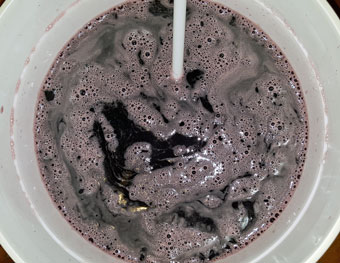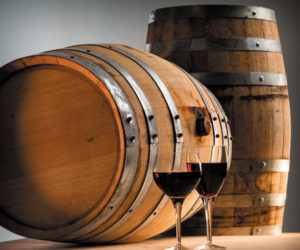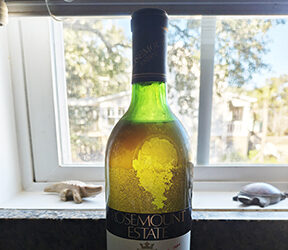Q
I’m looking to do a pyment (mead with grapes) and found a recipe on your site. I’m looking to do something a touch different, though. My question is this: How much gravity potential is in the 96 oz. (2.7 kg) can of grape concentrate? I want to use a Cabernet Sauvignon concentrate to make a richer red pyment and locate some grape skins to add tannic structure more like a dry red wine. Thanks!
Mike Henry
Harrisburg, Pennsylvania
A
Congrats for breaking out of the mold and taking it upon yourself to adapt a recipe to your own preferences! I always love it when readers, and my own winemaking buddies, take what they know or have done, and give it a good tweak. Pyment, or a fermented beverage made with both grape sugars and honey, is a tipple that’s not only tasty but one that’s often easier to make than a straight-up mead because the grape juice or concentrate provides additional micronutrients to yeast as well as additional tannin, flavors and aromas. For your calculations, grape juice concentrate sold via home winemaking supply houses, as well as commercially to big wineries (who use it sometimes to make up sugar in low-brix years) is standardized at 68 °Brix, or 1.3421 specific gravity.
You can certainly toss grape skins (marc or pomace) into your pyment to add even more red wine character like you say, but you could also buy some powdered grape tannin, use oak chips, or even use a cup of strong black tea to add some tannin backbone to the wine if it’d be tough for you to obtain grape skins. You could simply incorporate fresh red grapes as well, if you’ve got a source for them. For a dry red table wine style, be sure to start with an original must of at least 22 °Brix (1.092) in order to achieve 12.5 to 13% alcohol (exact conversion depends on yeast strain and fermentation rate). Much lighter and you won’t achieve that rich red wine style you appear to be looking for.
Q
My Cabernet Franc and Carménère both need their acid levels increased at bottling. Both went through malolactic fermentation. What type of acid should I use? I have acid blend but it contains malic acid. Wouldn’t adding malic acid defeat the purpose of malolactic fermentation?
Dennis DiRienzo
East Liverpool, Ohio
A
I would only adjust with tartaric acid, and not an “acid blend” that contains either malic or citric acids. Both of the latter can be fermented by organisms in the bottle. On the other hand, tartaric acid will stay put after you adjust it. Wine is especially rife with bacteria that will very happily eat malic acid, spitting out carbon dioxide gas, possibly-offensive off-odors (like diacetyl) and even possibly clouding up your wine with turbidity. Not fun.
Bacteria can metabolize citric acid into acetic acid and diacetyl, which is why I don’t recommend its use as a finishing acid either. The big downside to adjusting a wine’s acidity right before bottling, especially with tartaric, which can taste a little “harsh,” is that the acid just won’t have time to integrate in the bottle before you may want to drink it.
My longtime readers will know that I always advocate adding anything to your wine (if you are going to add anything to it at all) as early as possible in the wine’s life in order to give the elements the most amount of time to find themselves and make all the little chemical combinations (and possible instabilities) they’re going to make. That way, when it comes time to bottle, you have less chance of being surprised with a case of tartrate instability (crystals precipitating to the bottom of your bottles) or something even more unsavory, like a malic acid refermentation!
Q
Last spring we were in a local club store in Northeastern Florida where we live and were astonished to see vinifera vines for saIe. I don’t recall the exact varietals but am sure there were several red and white vines being offered. I have read that vinifera grapes do not do well in Florida for a variety of reasons – but we have an enclosed (in screen) courtyard area with an arbor and would love to train the vines over the arbor. If they offer the vines for sale again this year, do you think it would be reasonable to buy them?
Ron Caiazza
Palm Coast, Florida
A
I would be very cautious (or at least very realistic) about buying Vitis vinifera vines for your Florida vineyard. Most states in the country have their own burgeoning vineyard and winery region but there is a reason America’s “wine country” flourishes in places like Napa, California, and not Naples, Florida. It can be summed up in one word: disease. The steamy, humid and warm climate of most parts of Florida ensures that if you do buy some vinifera vines, you will be spending a great deal of time, and probably money, fighting off bacterial, fungal and insect problems. Powdery mildew, downy mildew, and especially Pierce’s Disease all wreak havoc on the vinifera grapes, which are just not resistant to that kind of pathological pressure.
You could give some Chardonnay or Cabernet a try, but why not plant something you know will flourish, especially since it seems your main aim is ornamental? In Florida, your native “Muscadine” type grapes (Vitis rotundifolia, sometimes called “Scuppernong”) do very well and are easy to obtain at local nurseries. The fruit is edible, so it can be used for the table, in jellies or in winemaking, though the flavor profile is what some would call “tropical” — tasting of ripe mango according to one description. Carlos, Pollyanna, Florida Fry, and Southern Home are all cultivars to try. If a straight-up muscadine is not your cup of tea and you want something that behaves a bit more like a traditional vinifera wine grape, you could also try some hybrid grapes, like Conquistador, Black Spanish, or Lake Emerald. Conquistador, for example, is a red bunch grape that is self-fertile (like a vinifera), and is Pierce’s Disease-resistant.
There are lots of resources in Florida for grapevine enthusiasts. Check out the University of Florida’s Mid- Florida Research and Education Center website at www.mrec.ifas.ufl.edu/grapes/grape-resources.asp, which is a great first step. Also visit the Florida Grape Grower’s Association at fgga.org. Both sites are extensive portals into the world of southern viticulture.
I recommend that you do some research before deciding to commit to a Vitis vinifera vine that likely will not give you the satisfaction you are looking for. I wager that a native or hybrid grape will do a much better job of beautifully growing over your arbor than a weak, struggling and disease-ridden vinifera attempt.
Q
I have always wondered why you cannot make sparkling wine in a regular wine bottle. Beer bottles are the same thickness as a wine bottle and they don’t explode. I was wondering, to deal with the exploding issue, whether you could make a lighter or less sparkling wine with less CO2 and alter the room in the neck by not filling it so much to accommodate the extra gas?
Marcello Pecchenino
Reno, Nevada
A
Ah, the Wiz has visions of broken bottles in your future and it’s a prognostication I wouldn’t like to see become reality. Let’s just say my Fermentation Magic 8 Ball says, “See that sign? Don’t go there!”
It’s never a good idea to try to make sparkling wine in regular wine bottles or even regular beer bottles, because neither vessel is designed to take the pressure of around 9,500-10,000 ppm CO2 that most sparkling wines carry.
Though certainly smaller and tougher than wine bottles, which helps them withstand the 4,000-6,000 ppm CO2 produced by beer, beer bottles just aren’t made thick enough. Many mead recipes (really a honey wine) and higher-gravity beer recipes actually suggest that they be bottled in sparkling wine bottles in order to not pose an explosion danger. Sparkling wine bottles are built much thicker, have a deep punt for structural integrity and have a lip for a crown cap or wire cage over the cork, though you may bottle sparkling wine, cider, mead etc. with just a crown cap.
That being said, a normal wine bottle can withstand some pressure. In fact, I just bottled my 2012 Napa Sauvignon Blanc with a purposeful 700 ppm of dissolved CO2, which is juuuust below tasting threshold for many people. That level is just enough to give the wine a little “lift” but not too much so that consumers will be aware of any “tiny bubbles” in their glass. I never like to bottle a wine with more than 1,000 ppm CO2 because at those levels I start to worry about corks pushing, especially if the wine warms up at all. I’ve known friends to bottle wines under screw caps with up to 1,300 ppm CO2, but if you use them, make sure to check with the maker of the cap so you know the upper limit of safe CO2 levels for closure integrity.
Dissolved CO2 levels are one of the many parameters that winemakers can tinker with going into bottling, and one that might interest you, especially if you plan on making wines that fizz. It’s especially critical to measure dissolved CO2 if you are making something extremely fizzy, like mead or sparkling wine; you want to make sure the bottles you’re planning on using will be up to the task. The easiest way to measure dissolved CO2 in a wine is to use a “carbodoseur” (about $200 at well-stocked wine lab supply houses), which is a funny term for what essentially looks like a glass measuring cylinder with a pipet sticking out of it. You physically agitate the wine, which off-gasses dissolved CO2, and “extra” wine shoots out of the little pipet. Then you compare the volume of wine to a little calibration chart and it gives you an estimate of the CO2 in the wine. It’s not 100% accurate, and you do have to correct for temperature (colder wine holds on to CO2 better), but it’s a great off the cuff way to find out if your beverage can take “beer bottle” glass or if you really should spend the money on sparkling wine bottles. Keep in mind, also, that trying to save money by re-using sparkling wine bottles multiple times is potentially problematic. Micro-cracks and weaknesses in the glass can develop over time, making the risk of an explosion increase every time you do so.
You can certainly try to use less “priming sugar” (to use a beer brewer’s term) in a sparkling wine or mead recipe to achieve a light sparkle as opposed to the full bore 10,000 ppm CO2 associated with the most fizzy bubblies. A rule of thumb from good ol’ Louis Pasteur is 100 grams of cane sugar yields about 50 grams of carbon dioxide gas, so measure carefully for your volume. Rather than leave more headspace, which, even if you’re gassing bottles, can contribute to oxygen pickup and oxidation, I would just use the strongest bottle you think you might need, just to be safe rather than sorry.
Q
How does the amount of yeast added to a must or juice affect the wine? A kit has one pack of yeast. What happens if yeast is doubled, tripled, etc.?
Wilbur Brinkmeyer
Taylor, Texas
A
There are a few effects on a wine if you add more yeast. Number one, the fermentation might start a little faster and go to completion faster because there are simply more cells to eat the sugar, and each can only eat a certain amount of sugar at a time. This will, in turn, increase the fermentation temperature, which is usually undesirable in winemaking unless you are fermenting in a very cold environment (for example, in your garage, mid-winter in Anchorage, Alaska) and want to make sure your fermentation really gets going. Temperatures under 50 °F (10 °C) will tend to slow down fermentation, so in a challenging temperature situation you might want to up the amount by 30–50% only. The same is true for fermenting anything in high-Brix (above 25) situations of overripe fruit or dessert wine production. If you throw a little more yeast at your fermenting wine, there is a better chance of having a complete fermentation.
There is no reason to ever double, triple or quadruple the amount of yeast called for in a winemaking recipe. More alcohol will not result because the amount of sugar in a given must or juice is fixed and can never increase beyond a certain point. Negatively, however, your yeast cells might be under-nourished during the fermentation because there will be less micronutrients, vitamins and biotin to go around; meaning the increased risk of a stuck fermentation is therefore very real. Additionally, extra yeast autolysis flavors and the potential for an anaerobic layer of hydrogen-sulfide (rotten egg smell) forming lees at the bottom of the container are possible aromatic risks. Most often, adding more yeast than what is called for will only waste money and allow that much more sediment to settle out once the fermentation is complete.
Related Links:
• For more information on everything yeast does for your wine (probably more than you ever wanted to know) check out WineMaker magazine’s August-September






